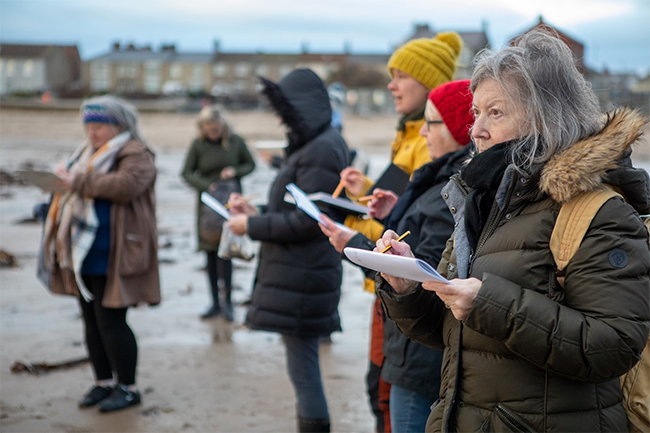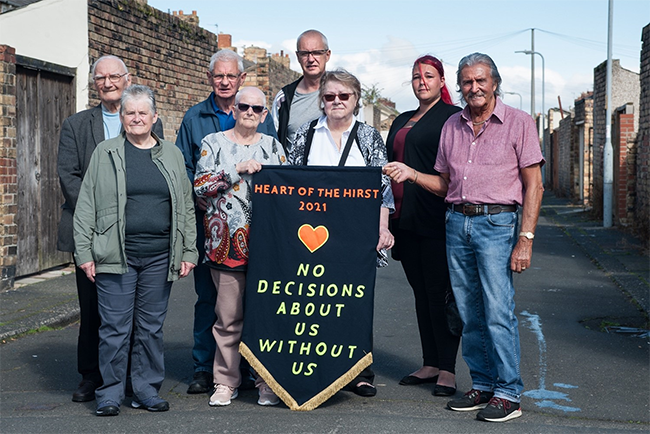The case study describes Museums Northumberland bait’s use of the Warwick and Edinburgh Mental Wellbeing Scale (WEMWBS) to build quantitative evidence of the positive impact on wellbeing of taking part in arts and culture.
Introduction
WEMWBS has been used on the advice of Northumberland County Council Public Health and the dataset built up over eight years consistently demonstrates 72-75 per cent of participants reporting an increase in wellbeing through interaction with our project, with a 15 per cent overall increase in wellbeing observed across the whole sample.
The challenge
Museums Northumberland bait is the Creative People and Places programme in South East Northumberland, funded by Arts Council England and Northumberland County Council Public Health. The ten year mission is to:
As an action research programme, we needed a robust methodology to measure changes in wellbeing at a community level and track progress towards this ten year mission.
There are very significant health inequalities within South East Northumberland. Data from the 2011 census shows that within South East Northumberland 22.1 per cent of people felt their day-to-day activities were limited as a result of poor health (11.1 per cent limited a lot, 11 per cent limited a little). Levels of obesity, alcohol misuse, heart disease and diabetes are above the national average and life expectancy overall is 10 years lower than in other parts of Northumberland.
Taking an asset-based approach, we work in partnership with groups and organisations that people know and trust to co-deliver the programme. This includes work with volunteer led resident’s groups alongside voluntary sector organisations such as Action for Children, Northumberland Recovery Partnership and Carers Northumberland. We therefore needed a wellbeing measurement tool that could be used in a wide variety of contexts.
The solution
WEMWBS has been validated for use in a range of geographical locations, cultural contexts, and settings. It is focused on positive aspects of mental health and is commonly used to track progression and impact over time, (e.g. to support public health initiatives or clinical studies).
WEMWBS data has been used by Museums Northumberland bait to generate a whole-population analysis, (i.e. assessing changes across a group of specific participants or programme-wide participants, rather than tracking individual impacts over time).
Based on guidance from Consortium partner Northumberland County Council Public Health, WEMWBS was chosen due to it:
-
providing a credible, user-friendly methodology
-
using a range of questions composed of ‘non-medical’ language
-
offering a straightforward approach to analysing the results
-
providing a means to assess changes in population wellbeing
-
facilitating the analysis of a combination of quantitative and qualitative evidence.
The impact
Analysis of the data gathered across the three phases of the Museums Northumberland bait programme reveals:
-
In each year of delivery of the programme, between 72-75 per cent of participants reported improvements in wellbeing via WEMWBS. A drop to 69 per cent in analysis completed in January 2022 is judged to be related to the impact of COVID-19 and the increase in social isolation.
-
A 15 per cent overall increase in wellbeing scores as a result of participants engaging in a range of creative activities.
Comparisons with UK population samples highlights the positive impact of the programme on wellbeing relative to national averages (the top 15 per cent of UK scores range from 60-70 and the bottom 15 per cent from 14-421).
-
The proportion of Museums Northumberland bait participants with scores equivalent to bottom 15 per cent of the UK sample decreased from 35 per cent to 16 per cent.
-
The proportion of Museums Northumberland bait participants with scores equivalent to top 15 per cent of the UK sample increased from 13 per cent to 25 per cent.
Importantly in terms of the legacy of the programme, a number of partners now recognise the value of engaging their clients, members and local community in creative activities. There is also greater recognition of the merits of measuring the impact to assess progress towards a range of socio-economic targets.
As a result, many partners have adopted creative activities to help them meet their own aims and service objectives. Crucially, this impact has been used to not only shape ongoing delivery, but also to inform funding bids and organisational capacity building based on a combination of WEMWBS data and qualitative feedback from staff and participants.
How is the new approach being sustained?
The Museums Northumberland bait programme will be delivered until the end of March 2023, and we will continue to use WEMWBS, adding to the existing dataset. We will also continue to work with voluntary sector partners in our area, sharing our learning about how to successfully embed WEMWBS into project delivery.
Trustees and staff at Museums Northumberland are keen to further understand the wellbeing impacts of all the Trust’s work. So far, the Arts for Wellbeing Manager has delivered training with the Collections Team who are working with a diverse group of volunteers over several years. The WEMWBS data is already starting to build a compelling picture of how taking part in high quality volunteering opportunities has a positive impact on the wellbeing of the cohort of volunteers.
The aspiration to have a positive impact on the wellbeing of local communities runs through all the work delivered by Museums Northumberland. Over the next three years there is a commitment to using WEMWBS and other wellbeing measurement tools, particularly in relation to capturing the impact of museum visits and shorter term engagements.
Lessons learned
Key areas of learning include:
-
WEMWBS can provide evidence of the wellbeing impacts of creative activities, with more robust evidence typically found from sustained periods of engagement. This complements evidence outlined in the report on arts, health and wellbeing produced for the All-Party Parliamentary Group Inquiry which suggests that participants need to complete around 100 hours per year (average of two hours per week) to impact on their wellbeing, highlighting the importance of regular engagement.
-
The benefits of providing a focal point and driving force such as the Museums Northumberland bait Arts for Wellbeing Manager to generate buy-in and consistency of approach amongst partners, artists and staff.
-
WEMWBS data helps to form a picture of what the wellbeing impact of engaging in creative activities can look like. Qualitative evidence can complement and enhance the quality of any analysis and evaluation of process and impact.
-
It is necessary to build trust, confidence and cohesiveness in a group before introducing WEMWBS and wellbeing analysis into the project process.
-
WEMWBS can provide difficulties for people with literacy issues, learning difficulties or for people for whom English is not their first language given the language used, potential differences in interpretation between cultures and the format of the assessment.
-
Feedback highlights concerns among some artists about measuring the wellbeing impacts of their work, alongside the practicalities of including WEMWBS data collection into their engagement with participants. Some artists have been unwilling or unable to administer the approach, requiring the Museums Northumberland bait team to take the lead.
-
COVID-19 has impacted negatively on the programme’s ability to administer the WEMWBS assessment with social distancing reducing the face-to-face contact needed to support people to complete the approach effectively.
-
WEMWBS is just one of a number of measures and approaches available. For example, the ‘ONS4’ subjective wellbeing questions on life satisfaction, sense of worth of activities, happiness and anxiety provide an alternative option to WEMWBS that contribute to Official Statistics and facilitate easier comparisons with wider datasets.
Contact
Rachel Adam, email: [email protected]
The full case study, Measuring the Impact on Wellbeing was written by Wavehill Research as part of the independent evaluation of the Museums Northumberland bait programme and was published in March 2022.


